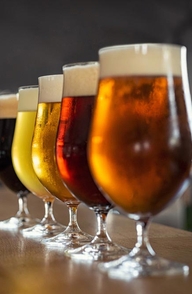Start 14-Day Trial Subscription
*No credit card required

Understanding the Role of Temperature in Beer Brewing
Uncover how mastering temperature control transforms beer brewing, from mashing to fermentation, ensuring every pint delivers optimal flavor, aroma, and quality with precision techniques.
Beer brewing relies on a precise balance of science and art. Temperature is the unsung hero behind every pint, impacting yeast activity, fermentation, and flavor development. Without strict control at each stage, a brewer risks ending up with flat or overly bitter results.
This guide explores how temperature makes or breaks the beer-making process. Whether you’re an enthusiast or looking to understand brewing technology’s role in refining taste profiles, stick around to uncover practical tips and deeper insights into this crucial element.
How Temperature Affects Each Stage of Brewing
Temperature isn’t just a factor, it’s the backbone of brewing. Every stage depends on hitting specific temperature ranges to create the right environment for chemical reactions.
In mashing, warm temperatures extract sugars from malted grains. Too high, and bitter tannins are released; too low, and there’s insufficient sugar extraction.
During fermentation, yeast thrives in set temperature zones to convert those sugars into alcohol and carbon dioxide. Deviations can lead to unwanted flavors or stalled activity altogether.
Even post-brewing steps like chilling impact beer quality significantly by halting fermentation at just the right time while stabilizing flavor profiles. Getting each range precise makes all the difference between bland beer and a balanced brew masterpiece!
The Role of Ice Machines in Cooling Processes Explained
Temperature control during cooling isn’t optional, it’s essential. Precision at this stage ensures the brew stops fermenting when intended, locking in flavors while preserving clarity.
Commercial-grade ice machines, like those from Hoshizaki ice machines, offer reliable and efficient cooling for breweries large or small. They maintain consistent temperatures through:
- Quick chilling: Immediately lower the wort temperature post-boil to prevent contamination.
- Stable cold storage: Keeps ingredients fresh before use and protects finished beer from spoilage.
- Customizable production rates: Scales to meet unique brewery needs without over-freezing water reserves.
Using these tools optimizes brewing efficiency while delivering a consistently crisp product ready for distribution or enjoyment!
Fermentation: The Heart of Flavor Development
Fermentation transforms a sweet liquid into beer, making it the heart of brewing. Beer yeast breaks down sugars, creating alcohol and carbonation, but only within specific temperature ranges.
For ales, warmer temperatures around 60–75°F encourage fruity and complex flavors. In contrast, lagers ferment best in cooler conditions between 45–55°F for clean and crisp profiles.
Temperature control is important here because it affects flavor and yeast health. Too high can kill the yeast or produce off-flavors, while too low slow fermentation entirely.
Proper cooling equipment ensures brewers maintain these critical ranges consistently, preserving quality batch after batch while allowing the beer’s character to develop without interference from unwanted reactions fully!
Tools for Monitoring and Controlling Brewing Temperatures
Achieving precise temperature control requires the right tools. Modern brewing equipment ensures each stage operates within ideal ranges, eliminating guesswork. Some essential tools include:
- Digital thermometers: Offer accurate readings in real-time for both hot and cold processes.
- Temperature controllers: Automatically regulate heating or cooling systems to maintain set ranges without manual adjustments.
- Cooling coils and immersion chillers: Efficiently reduce wort temperature post-boil to safe fermentation levels while minimizing contamination risk.
- Glycol systems: Provide advanced chilling solutions, especially in large-scale operations requiring continuous temperature stability.
These devices ensure brewers not only meet strict parameters but also create a consistently flavorful beer that matches their desired profiles!
Why Cold Storage is Key for Freshness and Quality
Cold storage plays a vital role in preserving beer’s freshness. Once fermentation is complete, temperature stability ensures the flavors remain consistent from the brewery to your glass.
Keeping beer at colder temperatures slows chemical reactions that can degrade its quality over time. For unpasteurized or craft varieties, this is even more critical since they lack preservatives found in mass-produced options. Incorrect storage can lead to oxidized flavors, flat carbonation, or even spoilage.
By using refrigeration systems tailored to specific needs, breweries protect their product throughout transport and distribution chains. This guarantees drinkers experience the intended taste profile every time without compromising on texture or aroma!
Wrapping Up
Temperature is the silent force shaping every beer’s flavor, aroma, and quality. From mashing to fermentation, cooling to storage, each step relies on precise control for consistent results.
By leveraging modern tools and maintaining proper ranges, brewers unlock the full potential of their craft. Every pint poured becomes a testament to how critical temperature truly is in transforming raw ingredients into a balanced brew masterpiece!



